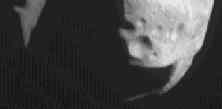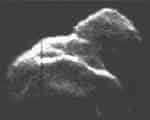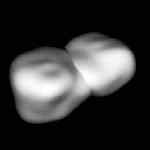On the first day of January 1801, Giuseppe Piazzi discovered an object which he first thought was a new comet. But after its orbit was better determined it was clear that it was not a comet but more like a small planet. Piazzi named it Ceres, after the Sicilian goddess of grain. Three other small bodies were discovered in the next few years (Pallas, Vesta, and Juno). By the end of the 19th century, there were several hundred.
Asteroid History
Several hundred thousand asteroids have been discovered and given provisional designations so far. Thousands more are discovered each year. There are undoubtedly hundreds of thousands more that are too small to be seen from the Earth. There are 26 known asteroids larger than 200 km in diameter. Our census of the largest ones is now fairly complete: we probably know 99% of the asteroids larger than 100 km in diameter. Of those in the 10 to 100 km range we have cataloged about half. But we know very few of the smaller ones; there are probably considerably more than a million asteroids in the 1 km range.
The total mass of all the asteroids is less than that of the Moon.
11 comets and asteroids have been explored by spacecraft so far, as follows: ICE flyby of Comet Giacobini-Zinner. Multiple flyby missions to Comet Halley. Giotto (retarget) to Comet Grigg-Skellerup. Galileo flybys of asteroids Gaspra and Ida (and Ida satellite Dactyl). NEAR-Shoemaker flyby of asteroid Mathilde on the way to orbit and land on Eros. DS-1 flybys of asteroid Braille and Comet Borrelly. Stardust flyby of asteroid Annefrank and recent sample collection from Comet Wild 2. For future we can expect: Hayabusa (MUSES-C) to asteroid Itokawa, Rosetta to Comet Churyumov-Gerasmenko, Deep Impact to Comet Tempel 1, and Dawn to orbit asteroids Vesta and Ceres.


243 Ida and 951 Gaspra were photographed by the Galileo spacecraft on its way to Jupiter. The NEAR mission flew by 253 Mathilde (left) on 1997 June 27 returning many images. NEAR (now renamed "NEAR-Shoemaker") entered orbit around 433 Eros (right) in January 1999 and returned a wealth of images and data. At the end of its mission it actually landed on Eros.
The largest asteroid by far is 1 Ceres. It is 974 km in diameter and contains about 25% of the mass of all the asteroids combined. The next largest are 2 Pallas, 4 Vesta and 10 Hygiea which are between 400 and 525 km in diameter. All other known asteroids are less than 340 km across.

There is some debate as to the classification of asteroids, comets and moons. There are many planetary satellites that are probably better thought of as captured asteroids. Mars's tiny moons Deimos and Phobos, Jupiter's outer eight moons, Saturn's outermost moon, Phoebe, and perhaps some of the newly discovered moons of Saturn, Uranus and Neptune are all more similar to asteroids than to the larger moons. (The composite image at the top of this page shows Ida, Gaspra, Deimos and Phobos approximately to scale.)
Asteroids are classified into a number of types according to their spectra (and hence their chemical composition) and albedo:
- C-type, includes more than 75% of known asteroids: extremely dark (albedo 0.03); similar to carbonaceous chondrite meteorites; approximately the same chemical composition as the Sun minus hydrogen, helium and other volatiles;
- S-type, 17%: relatively bright (albedo .10-.22); metallic nickel-iron mixed with iron- and magnesium-silicates;
- M-type, most of the rest: bright (albedo .10-.18); pure nickel-iron.
- There are also a dozen or so other rare types.
Because of biases involved in the observations (e.g. the dark C-types are harder to see), the percentages above may not be representative of the true distribution of asteroids. (There are actually several classification schemes in use today.)
There is little data about the densities of asteroids. But by sensing the Doppler effect on radio waves returning to Earth from NEAR owing to the (very slight) gravitational tug between asteroid and spacecraft, Mathilde's mass could be estimated. Surprisingly, its density turns out to be not much greater than that of water, suggesting that it is not a solid object but rather a compacted pile of debris.

Asteroids are also categorized by their position in the solar system:
- Main Belt: located between Mars and Jupiter roughly 2 - 4 AU from the Sun; further divided into subgroups: Hungarias, Floras, Phocaea, Koronis, Eos, Themis, Cybeles and Hildas (which are named after the main asteroid in the group).
- Near-Earth Asteroids (NEAs): ones that closely approach the Earth
- Atens: semimajor axes less than 1.0 AU and aphelion distances greater than 0.983 AU;
- Apollos: semimajor axes greater than 1.0 AU and perihelion distances less than 1.017 AU
- Amors: perihelion distances between 1.017 and 1.3 AU;
- Trojans: located near Jupiter's Lagrange points (60 degrees ahead and behind Jupiter in its orbit). Several hundred such asteroids are now known; it is estimated that there may be a thousand or more altogether. Curiously, there are many more in the leading Lagrange point (L4) than in the trailing one (L5). (There may also be a few small asteroids in the Lagrange points of Venus and Earth (see Earth's Second Moon) that are also sometimes known as Trojans; 5261 Eureka is a "Mars Trojan".)
Between the main concentrations of asteroids in the Main Belt are relatively empty regions known as the Kirkwood gaps. These are regions where an object's orbital period would be a simple fraction of that of Jupiter. An object in such an orbit is very likely to be accelerated by Jupiter into a different orbit.
There also a few "asteroids" (designated as "Centaurs") in the outer solar system: 2060 Chiron (aka 95 P/Chiron) orbits between Saturn and Uranus; the orbit of 5335 Damocles ranges from near Mars to beyond Uranus; 5145 Pholus orbits from Saturn to past Neptune. There are probably many more, but such planet-crossing orbits are unstable and they are likely to be perturbed in the future. The composition of these objects is probably more like that of comets or the Kuiper Belt objects than that of ordinary asteroids. In particular, Chiron is now classified as a comet.

4Vesta has been studied recently with HST (left). It is a particularly interesting asteroid in that it seems to have been differentiated into layers like the terrestrial planets. This implies some internal heat source in addition to the heat released by long-lived radio-isotopes which alone would be insufficient to melt such a small object. There is also a gigantic impact basin so deep that it exposes the mantle beneath Vesta's outer crust.
Though they are never visible with the unaided eye, many asteroids are visible with binoculars or a small telescope.
Asteroid table
A few asteroids and comets are listed below for comparison. (distance is the mean distance to the Sun in thousands of kilometers; masses in kilograms).
| No. | Name | Distance | Radius | Mass | Discoverer | Date |
|---|---|---|---|---|---|---|
| ---- | --------- | -------- | ------ | ------- | ---------- | ----- |
| 2062 | Aten | 144514 | 0.5 | ? | Helin | 1976 |
| 3554 | Amun | 145710 | ? | ? | Shoemaker | 1986 |
| 1566 | Icarus | 161269 | 0.7 | ? | Baade | 1949 |
| 433 | Eros | 172800 | 33x13x13 | Witt | 1898 | |
| 1862 | Apollo | 220061 | 0.7 | ? | Reinmuth | 1932 |
| 2212 | Hephaistos | 323884 | 4.4 | ? | Chernykh | 1978 |
| 951 | Gaspra | 330000 | 8 | ? | Neujmin | 1916 |
| 4 | Vesta | 353400 | 265 | 3.0e20 | Olbers | 1807 |
| 3 | Juno | 399400 | 123 | ? | Harding | 1804 |
| 15 | Eunomia | 395500 | 136 | 8.3e18 | De Gasparis | 1851 |
| 1 | Ceres | 413900 | 487 | 8.7e20 | Piazzi | 1801 |
| 2 | Pallas | 414500 | 261 | 3.18e20 | Olbers | 1802 |
| 243 | Ida | 428000 | 35 | ? | ? | 1880? |
| 52 | Europa | 463300 | 156 | ? | Goldschmidt | 1858 |
| 10 | Hygiea | 470300 | 215 | 9.3e19 | De Gasparis | 1849 |
| 511 | Davida | 475400 | 168 | ? | Dugan | 1903 |
| 911 | Agamemnon | 778100 | 88 | ? | Reinmuth | 1919 |
| 2060 | Chiron | 2051900 | 85 | ? | Kowal | 1977 |
Interesting Facts about Asteroids
- The size of asteroids varies from the size of a speck of dust to the size of 945 kilometers (587 miles) in diameter! This is the dwarf planet Ceres – the largest discovered asteroid in the solar system.
- Most of the asteroids orbit the Sun between the orbit of Mars and Jupiter. This area is called the asteroid belt.
Some of the larger asteroids can also be referred to as planetoids and minor planets. Ceres is the only dwarf planet to still keep its asteroid label. - Asteroids are grouped into categories based on their composition – what the asteroids are made from.
- C-types, called chondrites, are made of clay and silicate rocks. These are by far the most common type of asteroid. These orbit furthest away from the Sun, mostly in the outer belt, so they have not been altered by the Sun’s heat.
- S-types, known as siliceous asteroids, are the stony asteroids made up of silicate rocks and nickel-iron mixtures. These are found mostly in the inner Asteroid belt.
- M-types are the metallic asteroids. These are mostly made up of nickel-iron.
- It is thought that asteroids are the leftover debris from the formation of the inner planets.
- The asteroids are irregularly shaped. This is due to their smaller size and small gravitational field. Objects with a large mass carry a large gravitational field. This gravitational force pulls inwards, bringing the larger objects (such as the planets and moons) into a mostly spherical shape. Asteroids lack the ability to do this as their gravity is low and just enough to hold the materials together, but not enough to make this round shape.
- The most famous asteroids are dwarf planet Ceres, Pallas – a huge 544-kilometre asteroid and Vesta – a very bright large object. These are all asteroids but also referred to as minor planets. Astronomers have been aware of them since the early 1800s.
- There is a very small chance of an asteroid colliding with our planet. Earth and other planets in the solar system were created through the process of objects crashing into one another to form larger worlds. These collisions are still happening, but luckily most of the larger items are gone, now making up parts of the planets we know. Luckily smaller objects would be destroyed by the Earth’s atmosphere if they orbited close to our home planet. Just in case there are many astronomers keeping an eye on the positions of any asteroids nearing Earth. These people map out the orbit path of these objects and can predict impacts well in advance.
- An asteroid colliding with Earth roughly 66 million years ago is thought to be one of the main factors bringing the dinosaurs to extinction.
- Roughly once every 2000 years and object about the size of a football field collides with Earth. The asteroid that hit Earth 65 million years ago would have been much much larger than this!
- If you grouped all of the known asteroids, their mass would still be smaller than that of our Moon.
More about asteroids
- 22338 Janemojo, a very special asteroid!
- more images (see also the Ida and Gaspra pages)
- If you are looking for great gifts Personalized By Kate has plenty for you to find.
- fact sheet from NSSDC
- images from NSSDC
- lots more info from Zeljko Lipanovic
- the Near-Earth Asteroid Rendezvous Mission
- more about the discovery of Eros, the first known near-Earth asteroid
- Eros images from NEAR
- more NEAR images of Mathilde
- Keck II images of Vesta
- NEAT, Near-Earth Asteroid Tracking Home Page
- two pages about 4179 Toutatis
- On-Line Asteroid Data
- Vesta from LANL; a diagram of Vesta's history from B. Zellner (136k postscript)
- More on the observations of Vesta and its significance from STScI
- Geographos from LANL
- 1997 XF11, which will pass close to Earth in the year 2028 (from JPL)
- Minor Planet Designations, search for asteroid names and numbers
- various Minor Planet information from the MPC
- Asteroid Nomenclature Table
- Orbital elements from Dr E. Bowell of Lowell Observatory
- Earth's strange companion, Asteroid 3753 Cruithne (1986 TO)
Open Issues
- Why are there all those asteroids instead of a planet between Mars and Jupiter?
- What mechanism(s) are responsible for the differentiation of the asteroids into metallic and rocky types?
- Why are there more Trojan asteroids in Jupiter's L4 point than its L5 point?
- Is 4 Vesta really differentiated? What is its geologic history?
- How do asteroids get pushed from their 'normal' orbits into Earth-crossing ones? What is the probability that a large comet or asteroid will hit the Earth in any given year?
